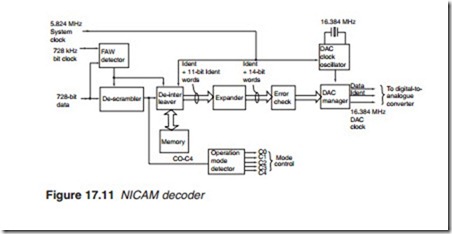NICAM decoder
The NICAM decoder descrambles, de-interleaves and reconstitutes the original 14-bit words. It provides data, ident and clock signals to a DAC to obtain the original L/R audio signals. A simplified block diagram of the decoding process is shown in Figure 17.11. The encoded data from the DQPSK detector is fed into the FAW detector for frame recognition and resetting of the descrambler and de-interleaver. The descrambled data is then fed into the de-interleaver, which reproduces the original dual- channel (L and R) data together with an L/R ident signal to select the signal paths as appropriate. De-interleaving is carried out by using a ROM look-up memory. The descrambled data is also fed to the operation mode detector which decodes control bits C0–C4 and provides information to the expander and other parts of the system in terms of the type of trans- mission, e.g. stereo, mono or bilingual.
Having restored each 11-bit word (10 + parity) to its correct order, they have to be expanded back to a 14-bit format. This is carried out by an expander, which functions in a complementary manner to the compressor at the transmitter but uses the scale factor embodied in the parity bits. This is followed by an error check circuit, in which the error parity is used to investigate and correct the bit stream. Before leaving the decoder for the DAC, the data is fed to a DAC manager to organise a three-line bus out- put consisting of a data bit stream, an ident signal and a DAC clock known as DACOSC. At the converter, the DAC clock is subdivided to accurately produce the sampling frequency. There are two formats for the three-line output bus that may be used to feed the DAC: the S-bus for converters using a 16.384-MHz clock and the I2S-bus for converters using an
8.192 MHz clock.
